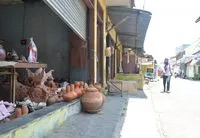An area in Cirebon known as Kampung Arab. This village has a long history of interest traced.

Cirebon is known to have a variety of traditions and cultures. In history Cirebon was built by a number of ethnic and ethnic groups.
In addition to Java and Sunda, ethnic Chinese and Arabs also have a role. One proof is the presence of Kampung Arab in Cirebon, precisely in Kelurahan Panjunan, District Lemahwungkuk, Cirebon, West Java.
The historian Cirebon, Opan Safari said the arrival of the Arab community to Cirebon around 1418, together with Sunan Gunung Jati or Shaykh Sharif Hidayatullah. Together with Sunan Gunung Jati, the Arab community participated to spread the teachings of Islam.
"The Arab army came with Syekh Nurjati or Syek Idofi Mahdi through the navigational path made by Cheng Ho. Then Sunan Gunung Jati came, but the method of disseminating Islam is different, Sunan Gunung Jati is more polite than others," said IAIN lecturer Syekh Nurjati Cirebon it when contacted detikTravel , Monday (9/10/2017).
In its development, continued Opan, Sunan Gunung Jati divides the region based on the tribe of its people. Because, many Arabs who choose to settle and marry the natives. Panjunan was chosen as the base of the citizens of Arab descent.
"The Arabs in Panjunan were once traders, and Panjunan was also known as a center of crafts from clay, but now that it has changed, there have been shops and Arabs are mingling with other people," he said.
Now Panjunan became an electronic center in Cirebon, only left no more than five stores that sell handicrafts from clay.
Meanwhile, Chairman of RW 5 Kendanjang Panjunan Urban Village, Zaki Mubarak said the handicraft saw in the past was dominated by native Cirebon. Arabs at that time also traded clay.
"Once there are many trades, all kinds of trades, now the Arabs in Cirebon are the majority open the perfume shop before the perfume, the furniture also grow here," Zaki said when met at home detikTravel.
Zaki also did not dismiss, the craft of clay or pottery had become a prima donna in Panjunan. In RW 5 Kenduruan, he continued to be a burning place of handicrafts. To manufacture the craft, said Zaki centered on RW 8 Panjunan. In addition, the evidence of the relics of the Arabs in Cirebon is the Red Mosque Panjunan which serve as one of the centers of spreading Islam in the land of Cirebon.
"My house was once a burning place mas, a kind of piggy bank continues to rich in jugs and other, now there are only two handicraft stores," he said.
He explained the arrival of Arab citizens in Cirebon started since the spread of Islam that was done during the Sunan Gunung Jati period. Zaki is also a descendant of the Arabs who admitted at this time the number of Arabs in Panjunan began to decrease.
"Now it's a lot of people moving in. About 30 percent is still here, if I stay here, I'm native to the Middle East, just not Saudi Arabia but Yemen," he said.
Despite the decline of the Arab population, Panjunan remains known as the Arab Village. Arabs in Panjunan have their own traditions, every celebration of entertainment and cuisine is always Arab flavor.
In addition, Zaki also said people of Arab descent in Panjunan are still active in hospitality, there are at least two communities that are still active ie Habaib and Al Irsyad. "Habaib is the same group of Shaykhs, but we are not clashed, Alhamdulilah is active, until now still active, such as monthly and weekly recitation
RE: New Contest from @Xpilar "home town" 30/11-2017 "get free upvote"